ALS (lateral amyotrophic sclerosis, motor neuronal disease, Charcot's or Lou Gehrig's disease) is a rare, progressive neurological disease. The causes of the pathology, characterized by damage to motor neurons, have not yet been clarified.
Record content:
- 1 Pyramidal tract anatomy
- 2 Causes of amyotrophic lateral sclerosis
- 3 What is the danger of pathology for humans?
- 4 Risk factors
-
5 Forms and symptoms of ALS
- 5.1 Cerebral form
- 5.2 Bulbar form
- 5.3 Cervicothoracic form
- 5.4 Lumbosacral form
- 5.5 Rare symptoms
-
6 Course of the disease
- 6.1 First symptoms
- 6.2 Disease development
- 6.3 Increase in symptoms
- 6.4 The last stage
- 7 Diagnostics
-
8 Treatment
- 8.1 Drug therapy
- 8.2 Physiotherapy
- 8.3 Speech therapy
- 8.4 Tracheotomy
- 8.5 New treatment methods
- 8.6 Folk methods
- 9 Patient care that improves quality of life
- 10 Help for people with ALS in Russia
- 11 Forecast
- 12 Video about BAS
Pyramidal tract anatomy
A person constantly makes some kind of movement, the responsibility for the implementation of which lies with the motor neurons. Performing any voluntary movement is possible only when impulses from the cerebral cortex reach the nerve endings located in the muscles.
Conduction of impulses is provided by the pyramidal tract, which originates in the frontal lobe of the cerebral cortex, where the motor center is located. The beginning of the pathway is the giant pyramidal Betz cells, it is in them that the motor signal is formed.
Bundles of nerve fibers (neurons) branch off from the pyramidal cells. Neurons, without interruption, pass through the parts of the brain and descend into the spinal cord. At the border of the brain and spinal cord, bundles of neurons are partially intertwined and diverge into the anterior and lateral columns of the spinal cord.
The pyramidal tract consists of nerve fibers, which, depending on their location in the conducting chain, are divided into central and peripheral. Central neurons are localized in the structures of the brain and spinal cord, while peripheral neurons are located in the muscles.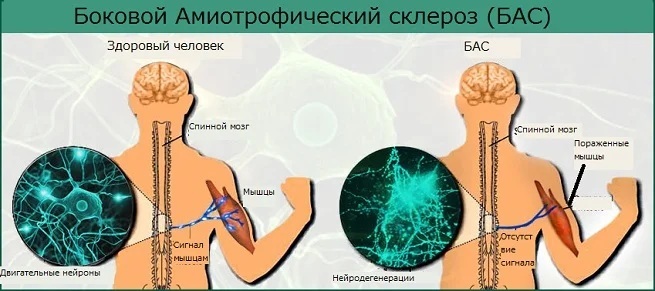
In each segment of the spinal cord, nerve fibers transmit impulses to peripheral motor neurons through synoptic endings.
So, the impulses entering the cervical region provide motor activity of the hands. The thoracic region is responsible for the movement of the trunk. The legs are set in motion by impulses entering the lumbar region.
If an obstacle arises in the path of the neural beam (injury, hemorrhage, tumor), the impulses do not reach the target and the muscle, not receiving a motor signal, is paralyzed, Partial obstruction of the nerve impulse causes paresis.
Causes of amyotrophic lateral sclerosis
ALS is a disease, the causes of which have not yet been identified. Currently experts attribute about 10% of all cases of the disease to the causes of heredity, the rest, according to scientists, are completely irregular.
There is a hypothesis that the cause of Charcot's disease can be viral infections, traumatic electrical injuries current, long-term hypovitaminosis, chronic and acute intoxication, malignant tumors, pregnancy.
There are suggestions that the disease may be caused by injury, excessive exercise and agricultural chemical poisoning. Sometimes pathology is associated with the aging of the body, but cases of its occurrence in children are known.
What is the danger of pathology for humans?
Motor neuronal disease is incurable and has a progressive course. A person rapidly loses motor abilities, his chewing, swallowing respiratory functions are impaired. Since the causes of the disease are unknown, its treatment is not effective and is aimed at alleviating the condition and somewhat prolonging life.
Risk factors
Specialists studying this neuropathology suggest that factors that increase the risk of ALS may be:
- work in hazardous production;
- the use of vegetables and fruits grown with the use of pesticides for food;
- smoking;

- military service (there is no explanation for this assumption).
Forms and symptoms of ALS
ALS is a disease, the causes of which are still unknown, has 4 main forms: cerebral, bulbar, cervicothoracic and lumbosacral. The forms differ in some parameters (the number of affected neurons, the area of the primary detected process), but many symptoms are identical for all forms.
Cerebral form
The cerebral form is characterized by damage to the central neuron. Against this background, paresis and hypertonicity of the muscles of the body appear. Memory deteriorates, thinking is impaired, intelligence decreases. The patient gradually loses control over muscle contractions.
Bulbar form
In this form, speech functions, first of all, suffer, language atrophy occurs, the act of swallowing becomes more complicated, and the gag reflex increases. The breathing process is inhibited, attacks of suffocation are repeated more and more often. Further, atrophy and high muscle tone of the limbs appear. A person ceases to control his behavior and mood.
This is the most severe form of the disease, as the respiratory and cardiovascular systems are affected over time. Patients with bulbar form are not helped by artificial ventilation.
Cervicothoracic form
In the cervicothoracic form, the disease develops depending on the type of neurons affected. In the case when a peripheral neuron is affected, pathological changes begin with the hand of one hand.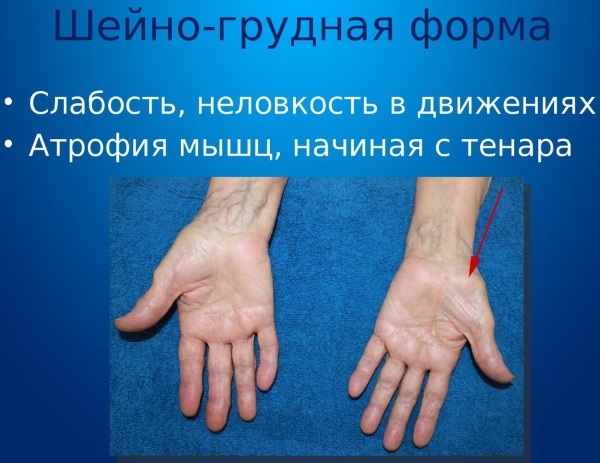
Strength and muscle tone decrease, and involuntary muscle contractions occur. Then the shoulder girdle and the other arm are included in the degenerative process. Paresis appears, muscles atrophy. The limbs become difficult to control. A person begins to control any movement.
Legs gradually lose strength and endurance. The disease, meanwhile, affects the cervical muscles and the bulbar region of the brain. The head cannot be kept in its natural upright position.
In another case, peripheral and central neurons are simultaneously affected. Symptoms occur in both hands, then lower extremities are affected. A "drooping foot" appears.
Lumbosacral form
In this case, two pathways of the disease development are also observed - ALS affects either a peripheral neuron or both neurons at once.
The disease often develops according to the first type - with damage to one neuron. Weakness appears in the muscles, the tendon reflex of the lower extremities decreases. Moreover, the symptoms occur in one leg, then move on to the other. Little by little, atrophic changes cover the arms, shoulder girdle and bulbar nerves.
Rare symptoms
ALS is a disease whose causes and mechanisms of development have not yet been fully understood; it has a number of symptoms that indicate other neurological pathologies. Despite this, diagnosticians take into account their existence when clarifying the diagnosis.
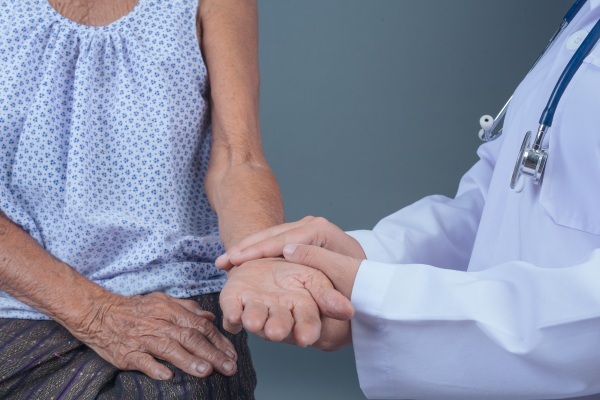
The course of the disease in each patient has an individual character. Sometimes such symptoms appear, the presence of which is completely unusual for this disease and is extremely rare. This may be a loss of mobility of the eyeballs, while vision does not change.
Sometimes patients lose control over the acts of urination and defecation. On the background of exhaustion, bedsores appear. Symptoms such as sensory impairment are rare. The patient does not feel his hands at all due to circulatory disorders. Dementia develops somewhat more often, memory worsens, intelligence decreases.
Course of the disease
The uniqueness of the disease lies in the fact that its manifestations are completely individual. It is very difficult to isolate common symptoms, since they are identical to other neurological diseases. However, some of them are described in the medical literature.
First symptoms
The onset of the disease is characterized by spasms and slight twitching of the muscles, weakness and numbness of the limbs. A person starts to stumble, he cannot even hold light objects in his hands.

Sudden, short-term cramps constrict the calf muscles and the muscles of the fingers and toes. One of the reasons to see a doctor is speech slowdown, difficulty with pronunciation.
Disease development
ALS is a disease, the causes of which continue to be studied by scientists around the world. Therefore, at the present stage, treatment is more likely aimed at eliminating or alleviating pronounced symptoms. Despite the efforts of doctors, the disease is progressing steadily. A person gradually loses the ability to perform the simplest motor operations.
Increase in symptoms
As the disease progresses, due to a decrease in physical activity, a person's legs begin to bend poorly, then he loses the ability to move. The head is not kept in a natural position and falls on the chest.
At the same time, speech slows down, it becomes indistinct or completely disappears. Problems with the respiratory system develop, and asthma attacks occur. Against the background of oxygen starvation, headaches, insomnia, hallucinations appear. Paralysis progresses.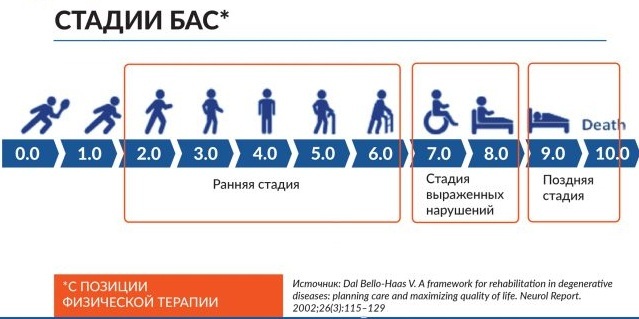
The patient has increased salivation, the reasons for which have no explanation. The patient chokes, he is transferred to enteral nutrition.
The last stage
The last stage of the disease is characterized by a completely helpless physical state of the patient with the preservation of mental health and clarity of thinking.
Diagnostics
Diagnosing ALS is difficult for several objective reasons:
- The disease belongs to the category of rare diseases, so doctors do not have a clear picture of its occurrence and course.
- Symptoms in the early stages of development do not allow conclusions to be drawn about the severity of the pathology.
- The manifestations of the disease in each patient are individual.
ALS is a neurological disease, therefore, at the first suspicious symptoms, the patient is referred to a neurologist. The doctor examines the patient, evaluates muscle tone, the quality of speech functions, checks reflexes, and identifies the causes of ailments. If you suspect the presence of Charcot's disease, additional tests are prescribed.
The main diagnostic methods include:
- magnetic resonance imaging (MRI) of the brain;
- electroneurography (ENG);
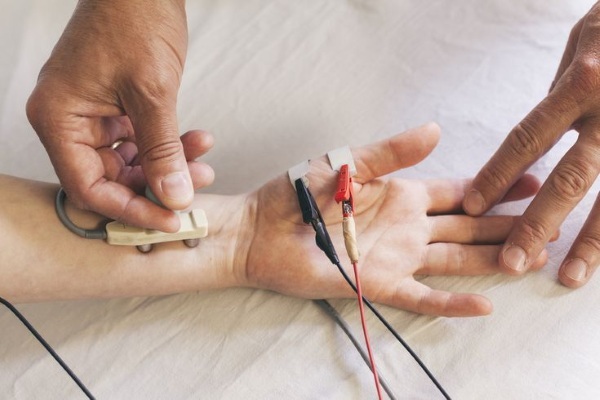
- electromyography (EMG);
- transcranial magnetic stimulation (TCMS);
- molecular genetic analysis;
- lumbar puncture (studies of cerebrospinal fluid - cerebrospinal fluid);
- tissue biopsy;
- blood chemistry.
There is a world practice of ALS diagnosis based on a specific set of signs:
- symptoms detected during examination - increased muscle tone and tendon reflexes, pathology of the hands and feet;
- damage to a peripheral neuron detected on EMG;
- changes occurring in the tissues identified by biopsy;
- atrophy of new muscles during the development of the disease.
Treatment
Charcot's disease has the status of an incurable chronic ailment. On average, the disease lasts 2 to 5 years and is fatal. Therapy is carried out in order to slow down the destructive processes in the body and maintain the patient's ability to self-care
The use of medicines can reduce pronounced symptoms and not lose the optimal quality of life. The patient should be aware that the course of the disease cannot be predicted. There are cases when sick people continue to fight the disease for several years and even decades.
Drug therapy
Drug therapy affecting the course of ALS is represented by the only drug prescribed for life - Riluzole. Taking Riluzole (other names Rilutek, Teglutik) requires strict medical supervision due to the possible development of medicinal hepatitis. Therefore, laboratory tests of blood for liver function tests are carried out every quarter.
In addition to the main drug, patients are prescribed means with the help of which particular problems are solved: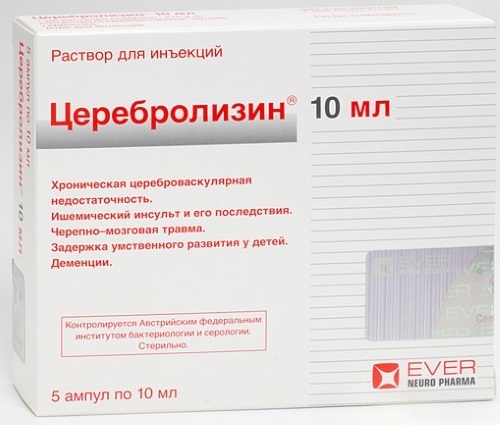
| Tasks | Name of drugs |
| Stimulation of speech and swallowing process | Galantamine, Proserin |
| Relief or reduction of muscle spasms | Sirdalud, Baclofen, Carnitine, Creatine, Elenium and Diazepam |
| Maintaining a psycho-emotional state | tranquilizers, hypnotics and antidepressants |
| Reducing the intensity of salivation | Amitriptilline |
| Removal of pain syndrome | NSAIDs, potent analgesics |
| Preservation and stimulation of brain activity | Piracetam, Cerebrolysin, Nootpropyl |
| Treating bacterial infections | antibiotics |
| muscle building | Retabolil |
| Increased resistance to other diseases; general strengthening of the body | B vitamins |
In cases of limited mobility of the joints of the lower extremities, as well as to prevent deformity of the feet, it is recommended to wear orthopedic shoes. Novocaine compresses or unloading bandages are applied to the affected shoulder joints.
In more severe cases, the use of special orthopedic devices is prescribed - wrist splints, head supports, and foot holders.
Physiotherapy
Diseases associated with impaired motor activity lead the body to physical inactivity. Physiotherapy exercises for ALS increases physical activity, normalizes respiratory function, and evokes positive emotions in those who are ill.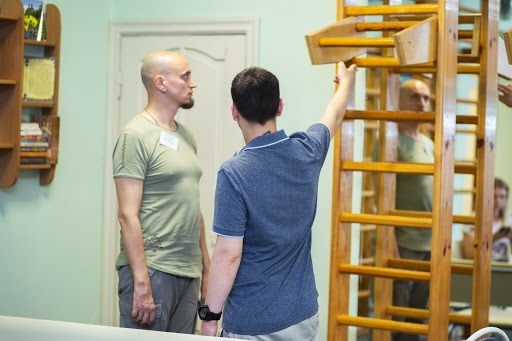
Physical education develops strength and elasticity of healthy muscles, increases joint mobility. Reduces muscle tension, partially eliminates pain. Physiotherapists develop personalized exercise plans for ALS patients so as not to be harmed by excessive exertion.
Speech therapy
In cases with ALS, the speech therapist assesses the degree of impairment, makes up a set of special exercises and helps in adapting to the ongoing changes. Classes with a speech therapist do not affect the state of motor neurons, but they slow down the degeneration of speech and swallowing functions.
Exercises recommended by a speech therapist, a person does independently at home or stationary. Experts recommend practicing for no more than 30 minutes. in a day. Periodically, the examinations of the speech therapist are repeated, and the exercise complexes are revised.
Tracheotomy
The progression of the disease leads to oxygen starvation. This is facilitated by atrophy of the respiratory muscles. A person cannot breathe deeply and exhale fully. Aspiratory disorders lead to the fact that saliva, mucus, small particles of food enter the respiratory tract. It becomes impossible to cough up phlegm. The risk of developing pneumonia increases.
In such situations, doctors recommend respiratory replacement therapy - artificial ventilation of the lungs. The ventilator effectively replaces the functions of weakened respiratory muscles, saturating the body with oxygen. In addition, mechanical ventilation provides the patient's own respiratory muscles with the necessary rest.
In the absence of serious bulbar disorders, ventilation of the lungs is recommended to be carried out by a non-invasive method. In this case, oxygen is supplied to the respiratory tract through the mask.
In more complex cases, a tracheostomy is performed - a dissection of the trachea (tracheotomy) and insertion of a plastic tube into the incision, to which the ventilator is connected. Invasive ventilation of the lungs is much more effective than mask oxygen delivery. A tube inserted through the tracheostomy closes the airway from the aspiration of various substances into the lungs.
Thus, aspiration pneumonia is excluded. But, at the same time, the tube does not allow air masses to pass through the vocal cords, and you can only talk using a special valve.
New treatment methods
In 2016, Masitinib was approved for the treatment of motor neuronal disease in the United States and several European countries.
In 2017 in Japan developed the drug Radicava (Edaravone), which slows down the progression of Charcot's disease.
In German and Japanese clinics, HAL therapy is used with the use of an exoskeleton - a special suit in the tissue of which sensors are placed that receive signals from the nerves. The exoskeleton enhances nerve signals and forces the muscles of a person to actively contract.
HAL therapy increases limb mobility, slows down the process of muscle atrophy, increases muscle mass, restores tone, reduces neuropathic pain, and allows the patient to move faster. The therapy does not stop the death of motor neurons and is aimed at preserving human motor activity.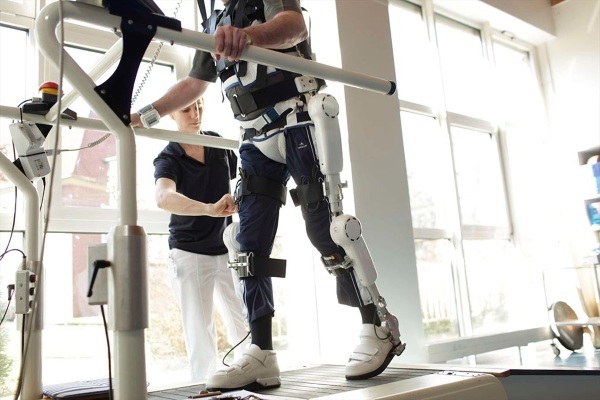
One of the most innovative technologies for treating amyotrophic lateral sclerosis, NurOwn, is based on the use of stem cells. Clinical studies show that stem cells injected into the cerebrospinal fluid replace dead motor neurons. Intramuscular injections of stem cells slow down the process of neuronal death.
Folk methods
Traditional medicine also does not ignore the problem of people with ALS and offers its own recipes prepared on a plant basis.
- Recipe 1. Rye and wheat grains germinated within 2 days are washed and taken in 1 tbsp. l. with the addition of 0.5 tsp. l. butter 3 times a day half an hour before meals. The course of treatment is 1 month, then a break is made for 5 days, and the course is repeated. Rich in vitamins, trace elements and proteins, which is very important in Charcot's disease, medicinal the product helps to reduce possible complications, to compensate for vitamin deficiencies, helps to strengthen organism.
- Recipe 2. The peel of 10-12 ripe horse chestnut fruits is crushed and infused for 3 days in 200-250 ml. The container is shaken periodically. Take a tincture before meals for 1 tsp. l. 3 times a day. It is advised to use an agent that prevents the formation of microthrombi in spring and autumn.
Patient care that improves quality of life
People who are diagnosed with amyotrophic lateral sclerosis very quickly lose the ability to take care of themselves on their own. Accordingly, their quality of life decreases. A person cannot do without outside care. Relatives should create the most comfortable conditions for the patient.
Despite the fact that the disease progresses rapidly, the person does not lose the ability to wash, hear, see and can communicate, for example, using a laptop. The extinction of motor activity is compensated for first by a walker, then by an automatic wheelchair, a bed with a lifting mechanism. In addition, over time, the patient needs to purchase a toilet chair.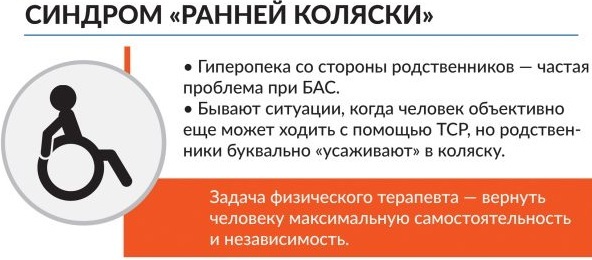
Close people should pay attention to the process of eating. The patient gradually loses the ability to chew and swallow food. Therefore, it should be of the consistency that allows the patient to swallow it with the least effort. In addition, food should be high in calories, rich in vitamins and proteins.
Help for people with ALS in Russia
Today in Russia there are from 15 to 20 thousand. patients with amyotrophic lateral sclerosis.
After a person is diagnosed with a fatal diagnosis and a disability is issued, he should contact a social welfare institution for rehabilitation means in accordance with an individual rehabilitation program and habilitation (IPRA). Close people should help the patient with this, because for the IPRA it is necessary to provide a lot of documents.
In addition, the "Live Now" charitable foundation provides assistance to people with amyotrophic lateral sclerosis. Here they provide the help of replacement nurses, organize consultations of doctors, teach relatives the rules of caring for the patient. On the terms of a free arena, the fund provides ventilators, NIVL and spitters.
The Family Council, which functions at the foundation, organizes leisure activities for the relaxation and communication of the sick.
In addition, there are 2 more funds operating in Moscow: the fund for helping patients with ALS at the Martha-Mariinsky center of mercy and the charitable foundation for helping G.N. Levitsky for ALS patients.
Forecast
Amyotrophic lateral sclerosis has a poor prognosis. The disease, depending on the form of its course, lasts from 2 to 5 years and ends in death. In some patients, these periods increase to 10 years or more.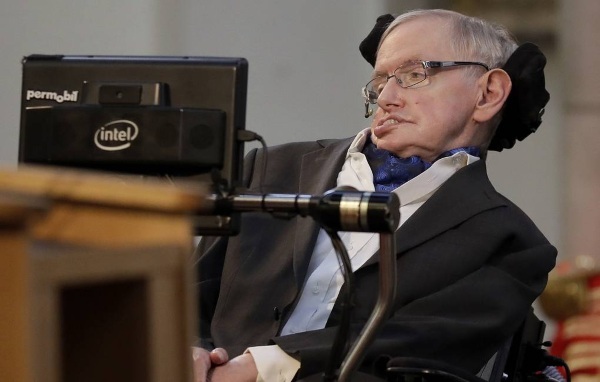
Stephen Hawking, an English physicist, writer, director of one of the centers of the University of Cambridge, was diagnosed with ALS at the age of 21. Gradually losing the ability to move and speak, Stephen Hawking continued to work and lived to be 76 years old.
ALS is still a poorly studied and incurable disease. However, scientific studies that have been ongoing for many years give hope that the causes of its occurrence will be clarified, and methods of treatment will be found.
Video about BAS
Malysheva about ALS:



